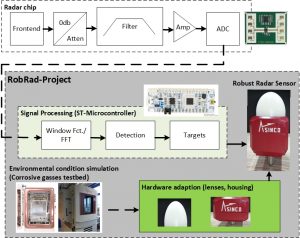Company info:
Name: ASINCO GmbH
Date founded: 2012
Number of employees: 25
Location: Duisburg, Germany
www.asinco.de
www.radarmesstechnik.de
Partners:


Innovation Management Partner:

Robustification of radar sensors for application in harsh industrial environments
Challenge
Due to the adverse environmental conditions in metal production, essential measurement technologies, e.g. optical and laser-based, reach their physical limits in various fields of application. Thus, observation of relevant process parameters stays fragmented over the whole process-chain.Radar-based measurement is insensitive to the adverse conditions (e.g. high temperature, dust, air humidity, mist from rolling emulsion or oil) and recording necessary measurement variables with sufficient precision. Due to advancement in innovative signal processing algorithms this is achieved without any discernible disadvantages compared to existing measurement technologies.
Solution
For improving the technological readiness level, well-structured and competently performed experiments and functionality tests are of core importance. Within the metal industry environmental conditions as high temperatures, dust, varying humidity and corrosive gases typically occur within the areas where sensors are located. This hinders many common sensors (optical, laser-based) from reaching their specified functionality.
The objectives within the application experiments in this project can be summarized as follows:
- Testing and improving sensor performance in terms of real-time capabilities for digital signal processing (sampling time: up to 1 kHz)
- Testing and improving sensor protection (housing) against harsh environment conditions with long-term continuous load tests against corrosive gases
- Testing and improving sensor protection (electronic) against harsh environment conditions with long-term continuous load tests with temperatures up to 100°C and variable humidity
FED4SAE Support
The increasing use of sensor intelligence and data preprocessing capabilities has been successfully tackled as well with the use of the industrialized STM. By transferring main raw data processing onto a decentral embedded system included in the sensor, core requirements are provided for effectively implementing the sensing units as self-aware CPS in industrial environments.
The simulation of real process environments by exploiting the functionalities of the advanced platforms of the corrosive gases testbed perfectly rounds of the improvement of the technological readiness level of the radar sensors. ASINCO is already closely interconnected within the pan-European community of radar sensors and additionally within the steel producing community. These cross-border collaborations can and will be further enhanced.
Impact
In close compliance with the targeted objectives of the call, this project tackles the development of further enhancing an already novel and smart solution of a technologically specialized SME. Thereby, it becomes possible to expand ASINCO’s leading position in the target market of providing robust measurement solutions for the metal producing industry.
The initiation and further pursuit of the robustification and market readiness development of radar-based sensors is the main interest for ASINCO. Numerous preliminary talks and discussions with various stakeholders from universities over research institutes to clients, clearly shows that the systems currently available on the market obviously do not meet industrial requirements.
There is currently great interest in testing radar measurement technology for applications such as product tracking, geometry and speed measurement and control on hot wide strip mills. The radar-based system technology to be further developed and especially robustified for the industrial application also has the potential to be used in almost every process stage of metal processing, from continuous casting (slabs) and hot rolling (hot strip, heavy plate) to cold rolling and finishing, as well as in long product plants. In a comparison of today’s optically- or laser-based measuring systems, a previously unattained field of application, namely much closer to the process, can be opened up.
With the entry of this new measuring technology, possibilities for process improvement with associated energy savings are attained at many points in the metal production process. There is also potential in the use of other materials such as plastics, glass, wood and paper.



